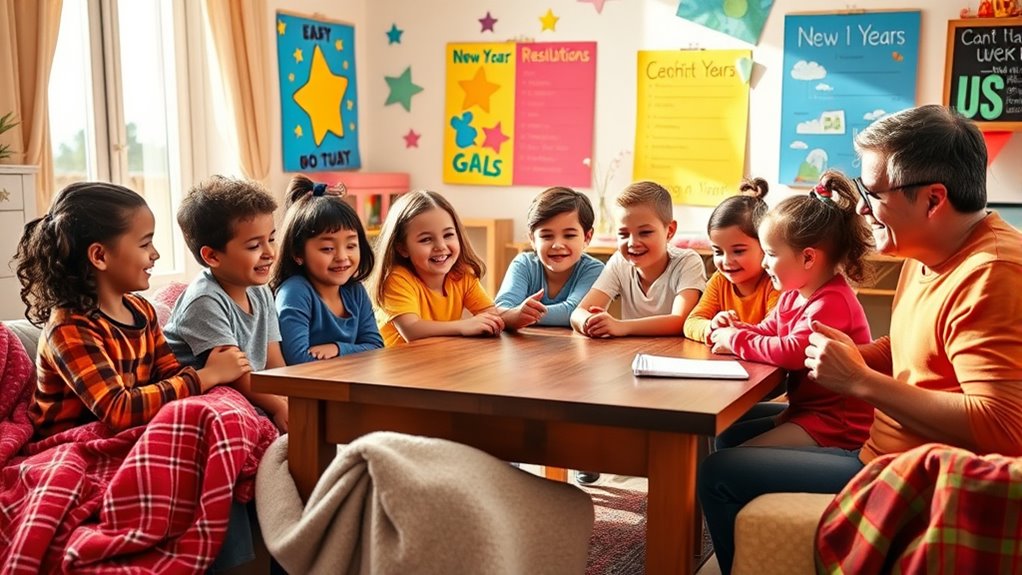Talking about New Year’s resolutions with your kids is a great way to teach goal setting and healthy habits. Keep the focus on small, actionable steps and involve them in choosing goals they’re excited about. Celebrate efforts and progress, even if setbacks happen, to build their confidence and resilience. By working together and modeling positive behaviors, you help them develop lifelong skills. Keep exploring to discover more effective ways to make goal-setting a fun and meaningful family activity.
Key Takeaways
- Involve kids in brainstorming resolutions to foster ownership and engagement.
- Emphasize small, achievable goals to build confidence and motivation.
- Use visual tools like charts or journals to track progress and celebrate successes.
- Normalize setbacks as part of growth, encouraging resilience and learning from mistakes.
- Model positive goal-setting behaviors to inspire children and demonstrate lifelong growth.

Have you ever wondered how to help your kids set meaningful goals for the New Year? It’s a great opportunity to teach them about goal setting and the importance of cultivating healthy habits. When you approach this conversation thoughtfully, you can inspire your children to develop a sense of purpose and confidence that lasts well beyond January. Instead of dictating what they should aim for, involve them in the process, helping them recognize what they truly want to achieve. Encourage them to think about goals that excite them and feel achievable, which makes following through more likely.
Start by explaining that goal setting isn’t about making perfect resolutions but about creating small, actionable steps toward better habits. For example, instead of saying, “I want to be healthier,” guide your kids to set specific goals like eating more fruits and vegetables or getting outside to play for 30 minutes each day. These are examples of healthy habits that they can incorporate into their daily routines. Breaking big ideas into manageable pieces helps kids see progress and keeps them motivated. When they experience success, no matter how small, it reinforces the value of setting goals and developing healthy habits.
Set small, clear goals like eating more fruits or playing outside to build healthy habits and stay motivated.
It’s also helpful to discuss how setbacks are part of the process. Sometimes, your child might forget to drink enough water or skip a workout, but that’s okay. Emphasize that slip-ups are normal and that they shouldn’t give up. Instead, they should view mistakes as opportunities to learn and grow. This mindset encourages resilience and a positive attitude toward self-improvement. Celebrate their efforts rather than just the outcomes. Praising their commitment reinforces the importance of consistency and effort in reaching their goals.
Make goal setting a collaborative activity. Sit down with your child and brainstorm ideas together. You can use a visual chart or a journal to track progress, making the process more engaging. Ask questions like, “What’s a small goal you’d like to work on this month?” or “How can we make healthy habits fun?” Providing support and guidance without taking over helps your child feel empowered and responsible for their growth. Remember, the goal isn’t perfection but progress. By focusing on achievable steps and healthy habits, you’re helping your child develop skills that will serve them well in many areas of life.
Additionally, understanding that personality traits can influence how children approach goal setting and setbacks can help parents tailor their support effectively. Ultimately, talking about New Year’s resolutions with kids gives you a chance to model positive behaviors. Show them that setting intentions and working toward them can be exciting and rewarding. With your encouragement, they’ll learn that goal setting isn’t just for the new year—it’s a lifelong tool for building confidence and leading a healthier, happier life.
Frequently Asked Questions
How Can I Help My Child Set Realistic Resolutions?
You can help your child set realistic resolutions by guiding them through goal setting that’s achievable and specific. Encourage them to break big goals into smaller steps, making progress manageable. Use positive reinforcement to celebrate their efforts and successes, boosting confidence. Remind them that setbacks are normal, and persistence matters. This supportive approach helps your child develop healthy habits and a positive mindset toward their resolutions.
When Is the Best Time to Discuss Resolutions With Kids?
Think of the new year as a blank canvas for your family’s goal setting. The best time to discuss resolutions is during family traditions, like New Year’s Eve or a special celebration, when everyone’s in a reflective mood. These moments foster open conversations and shared aspirations. By participating together, you help your child see resolutions as a positive tradition, inspiring them to set meaningful goals for the year ahead.
How Do I Motivate Reluctant Children to Make Resolutions?
To motivate reluctant children to make resolutions, try using reward systems that celebrate their progress, making the process fun and rewarding. Engage them with creative brainstorming, encouraging their ideas and interests. Show enthusiasm and support, helping them see resolutions as achievable goals. When they feel involved and rewarded, they’ll be more motivated to participate and stick to their resolutions, fostering a positive attitude toward self-improvement.
What Are Age-Appropriate Ways to Track Progress?
If you want to make goal setting exciting, turn progress tracking into a colorful adventure! Use simple charts, stickers, or drawings that kids can update daily or weekly. Celebrate every small achievement like a major victory—this keeps motivation soaring! Age-appropriate progress tracking makes kids feel like heroes, showing them their efforts truly matter. With fun tools, your child’s journey toward their resolutions becomes a thrilling and rewarding experience they’ll never forget.
How Can I Make the Resolution Discussion Fun for Kids?
You can make the resolution discussion fun for kids by incorporating creative activities and fun challenges. Turn goal-setting into a game, like a scavenger hunt for ideas or drawing their resolutions. Use colorful charts or stickers to track progress, making it visually engaging. Celebrate small wins with rewards or cheers, encouraging enthusiasm. Turning it into an interactive, playful experience helps kids stay excited and motivated about their resolutions.
Conclusion
Talking about New Year’s resolutions with kids is a great way to start the year fresh and build positive habits. Remember, it’s never too early to plant seeds of self-improvement, and your encouragement can make all the difference. Keep the conversation open and supportive—after all, you’re their guiding star. When you show you believe in them, you’re helping your kids reach for the stars and turn their dreams into reality.









